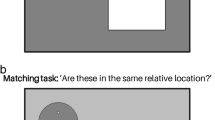Abstract
People sometimes appear to represent graphical information by analogy to space. In this paper we consider the extent to which the tendency to represent information by analogy to space calls on spatial resources. We also examine whether people who represent graphical information spatially also represent numerical information using a spatial number line. Forty-eight adult participants carried out a series of graphical reasoning, number judgement and spatial working memory tasks. Evidence was found to suggest that people were forming spatial representations in both the number judgement and graphical reasoning tasks. Performance on the spatial memory task was positively associated with a measure of the tendency to use spatial representations on the graph task. In addition, measures of the use of spatial representations for the graph and number tasks were associated. We interpret our results as providing further evidence that people often represent graphical information by analogy to space. We conclude with a discussion of whether the use of such spatial representations is confined to any one task or is instead a general representational strategy employed by people high in spatial ability.
Preview
Unable to display preview. Download preview PDF.
Similar content being viewed by others
References
Evans, J.S.B.T., Newstead, S.N., Byrne, R.M.J.: Human Reasoning: The Psychology Of Deduction. Lawrence Erlbaum Associates Ltd., Hove (1993)
Feeney, A., Hola, A.K.W., Liversedge, S.P., Findlay, J.M., Metcalfe, R.: How people extract information from graphs: Evidence from a sentence-graph verification paradigm. In: Anderson, M., Cheng, P., Haarslev, V. (eds.) Diagrams 2000. LNCS (LNAI), vol. 1889, pp. 149–161. Springer, Heidelberg (2000)
Feeney, A., Webber, L.: Analogical representation and graph comprehension. In: Butz, A., krüger, A., Olivier, P. (eds.) SG 2003. LNCS, vol. 2733, pp. 212–221. Springer, Heidelberg (2003)
Webber, L., Feeney, A.: How people represent and reason from graphs. In: Alterman, R., Kirsh, D. (eds.) Proceedings of the 25th Annual Conference of the Cognitive Science Society, Lawrence Erlbaum Associates, Mahwah (2003)
Pinker, S.: A Theory of Graph Comprehension. In: Freedle, R. (ed.) Artificial Intelligence and the Future of Testing, pp. 73–126. Lawrence Erlbaum Associates Ltd., Hillsdale (1990)
Carpenter, P.A., Shah, P.: A Model of the Perceptual and Conceptual Processes in Graph Comprehension. Journal of Experimental Psychology: Applied 4, 75–100 (1998)
Trafton, G., Trickett, S.: A new model of graph and visualization usage. In: Moore, J.D., Stenning, K. (eds.) Proceedings of the 23rd Annual Conference of the Cognitive Science Society, pp. 1048–1053 (2001)
Trafton, J.G., Kirschenbaum, S.S., Tsui, T.L., Miyamoto, R.T., Ballas, J.A., Raymond, P.D.: Turning pictures into numbers: Extracting and generating information from complex visualizations. International Journal of Human-Computer Studies 53, 827–850 (2000)
Dehaene, S., Bossini, S., Giraux, P.: The mental representation of parity and number magnitude. Journal of Experimental Psychology: General 122, 371–396 (1992)
Giaquinto, M.: What cognitive systems underlie arithmetical abilities? Mind & Language 16, 56–68 (2001)
Dehaene, S., Dehaene-Lambertz, G., Cohen, L.: Abstract representations of numbers in the animal and human brain. Trends in Neurosciences 21, 355–361 (1998)
Duyck, W., Vandierendonck, A., De Vooght, G.: Conditional reasoning with a spatial content requires visuo-spatial working memory. Thinking and Reasoning 9, 267–287 (2003)
Klauer, K.C., Stegmaier, R., Meiser, T.: Working memory involvement in propositional and spatial reasoning. Thinking and Reasoning 3, 9–47 (1997)
Gilhooly, K.J., Logie, R.H., Wynn, V.: Syllogistic reasoning tasks, working memory and skill. European Journal of Cognitive Psychology 11, 473–498 (1999)
Vandierendonck, A., De Vooght, G.: Working memory constraints on linear reasoning with spatial and temporal contents. Quarterly Journal of Experimental Psychology 50A, 803–820 (1997)
MacLeod, C., Hunt, E.B., Mathews, N.N.: Individual differences in the verification of sentence-picture relationships. Journal of Verbal Learning and Verbal Behavior 17, 493–507 (1978)
Capon, A., Handley, S., Dennis, I.: Working memory and reasoning: An individual differences perspective. Thinking and Reasoning 9, 203–244 (2003)
Bacon, A.M., Handley, S.J., Newstead, S.E.: Individual differences in strategies for syllogistic reasoning. Thinking & Reasoning 9, 133–168 (2003)
Moyer, R.S., Landauer, T.K.: Time required forjudgements of numerical inequality. Nature 215, 1519–1520 (1967)
Shah, P., Miyake, A.: The separability of working memory resources for spatial thinking and language processing: An individual differences approach. Journal of Experimental Psychology: General 125, 4–27 (1996)
De Soto, S.B., London, M., Handel, S.: Social reasoning and spatial paralogic. Journal ofPersonality and Social Psychology 2, 513–521 (1965)
Potts, G.R., Scholz, K.W.: The internal representation of a three-term series problem. Journal of Verbal Learning and Verbal Behavior 14, 439–452 (1975)
Hegarty, M., Sims, V.K.: Individual differences in mental animation during mechanical reasoning. Memory & Cognition 22, 411–430 (1994)
Hegarty, M.: Capacity limits in diagrammatic reasoning. In: Anderson, M., Cheng, P., Haarslev, V. (eds.) Diagrams 2000. LNCS (LNAI), vol. 1889, pp. 194–206. Springer, Heidelberg (2000)
Clark, H.H.: Linguistic processes in deductive reasoning. Psychological Review 76, 387–404 (1969)
Johnson-Laird, P.N.: Deductive reasoning. Annual Review of Psychology 50, 109–135 (1999)
Gattis, M.: Spatial schemas and abstract thought. MIT Press, Cambridge (2001)
Potts, G.R.: Information processing strategies used in the encoding of linear orderings. Journal of Verbal Learning and Verbal Behavior 11, 727–740 (1972)
Hummel, J.E., Holyoak, K.J.: A process model ofhuman transitive inference. In: Gattis, M. (ed.) Spatial schemas and abstract thought, pp. 279–305. MIT Press, Cambridge (2001)
Dehaene, S., Piazza, M., Pinel, P., Cohen, L.: Three parietal circuits for number processing. Cognitive Neuropsychology 20, 487–506 (2003)
Walsh, V.: A theory of magnitude: Common cortical metrics of time, space and quantity. Trends in Cognitive Sciences 7, 483–488 (2003)
Author information
Authors and Affiliations
Editor information
Editors and Affiliations
Rights and permissions
Copyright information
© 2004 Springer-Verlag Berlin Heidelberg
About this paper
Cite this paper
Feeney, A., Adams, J., Webber, L., Ewbank, M. (2004). Individual Differences in Graphical Reasoning. In: Blackwell, A.F., Marriott, K., Shimojima, A. (eds) Diagrammatic Representation and Inference. Diagrams 2004. Lecture Notes in Computer Science(), vol 2980. Springer, Berlin, Heidelberg. https://doi.org/10.1007/978-3-540-25931-2_27
Download citation
DOI: https://doi.org/10.1007/978-3-540-25931-2_27
Publisher Name: Springer, Berlin, Heidelberg
Print ISBN: 978-3-540-21268-3
Online ISBN: 978-3-540-25931-2
eBook Packages: Springer Book Archive




